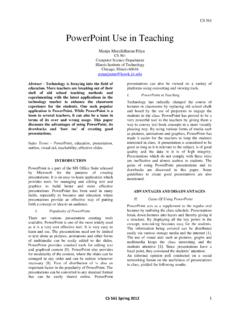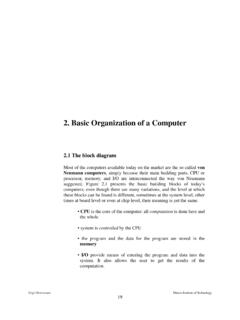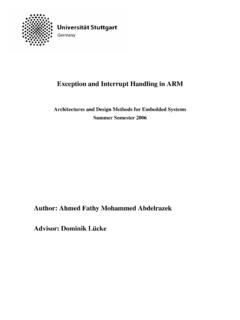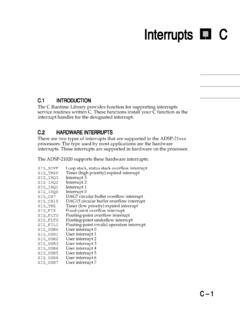Transcription of Exceptions in MIPS
1 1996, Virgil BistriceanuExceptions in MIPSO bjectivesAfter completing this lab you will: know the exception mechanism in MIPS be able to write a simple exception handler for a MIPS machineIntroductionBranches and jumps provide ways to change the control flow in a can also change thecontrol flow in a MIPS convention calls anexception any unexpected change in control flow regardless of its source ( distinguishing between a within the processor source and an external source).An exception is said to be synchronous if it occurs at the same place every time a program is executed withthe same data and the same memory allocation.
2 Arithmetic overflows, undefined instructions, page faults aresome examples of synchronous Exceptions . Asynchronous Exceptions , on the other hand, happen with notemporal relation to the program being executed. I/O requests, memory errors, power supply failure are exam-ples of asynchronous is an asynchronous exception . Synchronous Exceptions , resulting directly from the execution ofthe program, are an exception happens, the control is transferred to a different program namedexception handler, writ-ten explicitly for the purpose of dealing with Exceptions .
3 After the exception , the control is returned to theprogram that was executing when the exception occurred: that program then continues as if nothing hap-pened. An exception appears as if a procedure (with no parameters and no return value) has been inserted inthe the code for the exception handler might be executed at any time, there can be no parameters passed toit: passing parameters would require prior preparation. For the same reason there may not be any return is important to keep in mind that the exception handler must preserve the state of the program that was inter-rupted such that its execution can continue at a later with any procedure, the exception handler must save any registers it may modify, and then restore thembefore returning control to the interrupted program.
4 Saving registers in memory poses a problem in MIPS:addressing the memory requires a register (the base register) in which the address is formed. This means that7 1996, Virgil Bistriceanua register must be modified before any register can be saved! The MIPS register usage convention (see Lab-oratory 4) reserves registers$26 and$27 ($k0 and$k1) for the use of the interrupt handler. This meansthat the interrupt handler can use these registers without having to save them first. A user program that usesthese registers may find them unexpectedly MIPS exception mechanismThe exception mechanism is implemented by the coprocessor 0 which is always present (unlike coprocessor1, the floating point unit, which may or may not be present).
5 The virtual memory system is also implementedin coprocessor 0. Note however that SPIM does not simulate this part of the CPU operates in one of the two possible modes,user andkernel. User programs run in user mode. TheCPU enters the kernel mode when an exception happens. Coprocessor 0 can only be used in kernel whole upper half of the memory space is reserved for the kernel mode: it can not be accessed in usermode. When running in kernel mode the registers of coprocessor 0 can be accessed using the followinginstructions:The relevant registers for the exception handling, in coprocessor 0 areThe BadVAddr registerThis register (its name stands forBad VirtualAddress) will contain the memory address where the exceptionhas occurred.
6 An unaligned memory access, for instance, will generate an exception and the address wherethe access was attempted will be stored in which access the registers of coprocessor 0 InstructionCommentmfc0 Rdest, C0srcMove the content of coprocessor s registerC0src toRdestmtc0 Rsrc, C0destInteger registerRsrc is moved to coprocessor s registerC0destlwc0 C0dest, addressLoad word fromaddress in registerC0destswc0 C0src, addressStore the content of registerC0srcataddressin memoryException handling registers in coprocessor 0 Register NumberRegister NameUsage8 BadVAddrMemory address where exception occurred12 StatusInterrupt mask, enable bits, and status when exceptionoccurred13 CauseType of exception and pending interrupt bits14 EPCA ddress of instruction that caused exception 1996, Virgil BistriceanuThe Cause registerThe Cause register provides information about what interrupts are pending (IP2 to IP7) and the cause of theexception.
7 The exception code is stored as an unsigned integer using bits 6-2 in the Cause register. The layoutof the Cause register is presented IPi becomes 1 if an interrupt has occurred at level i and is pending (has not been serviced yet). The bitsIP1 and IP0 are used for simulated interrupts that can be generated by software. Note that IP1 and IP0 are notvisible in SPIM (please refer to the SPIM documentation).The exception code indicates what caused the 0 indicates that an interrupt has occurred. By looking at the individual IPi bits the processor can learnwhat specific interrupt Status registerThe Status register contains an interrupt mask on bits 15-10 and status information on bits 5-0.
8 The layout ofa. Codes from 1 to 3 are reserved for virtual memory,(TLB Exceptions ), 11 is used to indicate that a partic-ular coprocessor is missing, and codes above 12 areused for floating point Exceptions or are codesa implemented by SPIMCodeNameDescription0 INTI nterrupt4 ADDRLLoad from an illegal address5 ADDRSS tore to an illegal address6 IBUSBus error on instruction fetch7 DBUSBus error on data reference8 SYSCALL syscall instruction executed9 BKPT break instruction executed10 RIReserved instruction12 OVFA rithmetic overflow31-16IP7 IP6 IP5 IP4 IP3 IP215 14 13 12 11 10IP1 IP009807 ExcCode6 5 4 3 21 00 1996.
9 Virgil Bistriceanuthe Status register is presented bit IMi is 1 then interrupts at level i are enabled. Otherwise they are disabled. In SPIM IM1 and IM0 arenot visible to the (bit 1 in the register) indicates whether the program is running in user (KUc = 1) or kernel (KUc = 0)mode. KUp (bit 3 in the register) indicates whether the processor was in kernel (KUp = 0) or user mode whenlast exception occurred. This information is important since at the return from the exception handler the pro-cessor must be in the same state it was when the exception happened.
10 Bits 5-0 in the Status register implementa simple, three level stack with information about previous Exceptions . When an exception occurs, thepre-vious state (bits 3 and 2) is saved as theold state and thecurrent state is saved as theprevious state is lost. Thecurrent state bits are both set to 0 (kernel mode with interrupts disabled). At thereturn from the exception handler (by executing arfe instruction), theprevious state becomes thecur-rent state and theold state becomes theprevious. Theold state is not Interrupt Enable bits (IEj) indicate whether interrupts are enabled (IEj = 1) or not (IEj = 0) in the respec-tive state.











